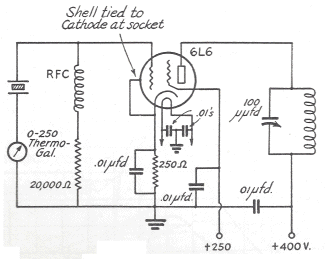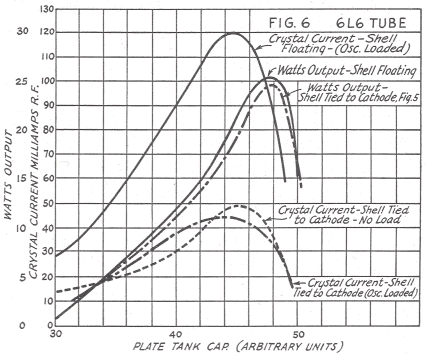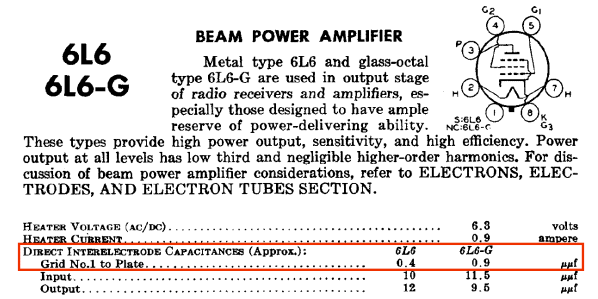
The 6L6 tube . . . has been used by many as a crystal oscillator and, because of its high power output capabilities, it appears naturally adapted to simple and compact transmitter design. The plate-to-grid capacitance, however, is rather high, the shielding effect of the screen being none too effective. This is evidenced by the necessity of neutralization when the tube is used as an amplifier; even as a doubler, trouble has been experienced with self-oscillation. It is an easy tube to excite, but because of its high amplification factor, difficulty with self-oscillation is encountered, and this makes it difficult to use in some circuits.—J. M. Wolfskill, W8QKT, "Operating Notes on Power Crystal Oscillators," February 1937 QST
The first tests conducted on the beam type power tube were made with the 6L6G. The performance curves were similar to those of any pentode crystal oscillator, with the exception that the crystal current was abnormally high. The crystal current on a 7-Mc. crystal was 100 ma. with 400 volts on the plate and 250 volts on the screen. This was in the loaded condition and a power output of 25 watts was obtained. The normal rated crystal current through a 7-Mc. crystal is 100 ma., and as long as the oscillator was loaded this value was not exceeded. But as soon as the load was removed, the current rose to 175 ma., which is just about the breaking point of the crystal. With a 14-Mc. crystal, the r.f. current rose to 150 ma. when loaded, which is the rated r.f. current for this type of crystal. In all cases, with the load removed the crystal current was anywhere from 50% to 75% over rated values.
Considerable difficulty was encountered in attempting to duplicate results, and the tube showed a tendency at times to go into self-oscillation. In order to remedy some of these troubles, all leads were made as short as possible, particularly the cathode connection to ground. The screen voltage was taken directly from a bleeder resistor in the oscillator power supply and was, at all times, kept below 275 volts. Any voltage above this caused the screen to run red, and in this condition the crystal would not start oscillating. Maintenance of the proper screen voltage remedied the tendency to go into self-oscillation and results were fairly consistent. However, the crystal current was still above rated values. The only safe bet with this tube is to reduce the plate voltage to 350 and screen voltage to 200 volts, using a cathode resistor of 250 ohms and a grid resistor of 10,000 ohms. Under these conditions, an output of 16 to 18 watts may be expected with either 7- or 14-Mc. crystals. Because of the greater thickness of 3.5- and 1.75-Mc. crystals, the crystal current did not exceed rated values even with higher voltages on these lower frequencies.
If a metal type tube is used, something can be done about overloading these higher-frequency crystals. Practically all available information about this tube suggested that the metal shell should be left floating. When this is done, the tube performs exactly like the glass tube. However, by connecting the shell to cathode, at the socket, the effective feedback to the crystal is greatly reduced and the crystal current is cut almost in half. Using the circuit shown in Figure 5, the crystal current with both 14- and 7-Mc. crystals was reduced by more than 50% over what it was when the shield was floating. Apparently the fact that the shield when floating was at a high r.f. potential caused excessive feedback to the crystal. At the same time that this reduction in crystal current was obtained, the output remained practically the same, the crystal was still oscillating strongly enough to drive the tube, and there was an increase in plate current. In other words, the efficiency remained the same as in the floating condition. When [the tube is] used in this manner, 250 volts may be applied to the screen and 400 volts to the plate without danger to the crystal. In fact it was necessary to increase the grid resistor to 20,000 ohms, in addition to the cathode bias, in order to key the crystal rapidly. It was also possible when using the tube in this manner to remove the load from the oscillator without having the crystal current go up above rated values.
 |
| Figure 5 — The beam tube circuit used in the tests. |
The curves in Figure 6 show the performance of the tube under the two conditions, shell grounded and floating, as the plate tank is tuned through resonance. These curves were taken with a 7-Mc. crystal, and the circuit constants were as shown in Figure 5. Notice the marked decrease in crystal current and the small drop in power output. With 3.5- and 1.75-Mc. crystals, the shell may be left floating since tests show that the crystal current was not excessive at these frequencies. Because of the tendency for this tube to self-oscillate when a tank circuit is connected in the cathode, caution should be used in Tri-tet operation. With all beam power tubes the screen voltage preferably should be obtained from a dividing resistor, and not from a series dropping resistor.
 |
| Figure 6 — Graph of 6L6 test oscillator crystal current and output versus tuning capacitor position for glass and grounded-metal-shell versions of the tube. Figure A and its caption explain the reason for the difference. |
 |
| Figure A — Image of partial 6L6/6L6-G data from RCA's 1948 Receiving Tube Manual (RC15) showing interelectrode capacitances for the glass and metal versions of the tube. The metal 6L6 is generally easier on crystals because its 0.4-pF control-grid-to-plate capacitance is less than half of that of the glass version (0.9 pF). Some transmitting-specialized variants of the 6L6 had control-grid-to-plate capacitances of greater than 1 pF; examples of these included the Raytheon RK-49 (1.4 pF) and the Hytron 6L6GX (1.5 pF). Using a close-fitting, grounded-to-chassis metal shield around modern miniature tubes (that contain only one tube per envelope) can similarly effect a near halving of control-grid-to-plate capacitance. [caption by David Newkirk, W9BRD] |
The 807 Tube
A relatively new tube to take the place of the 6L6 as a transmitting tube has been announced recently. This glass tube has the same beam power operating principle as the 6L6, and gives large power outputs with low plate voltages. It has considerably better shielding and requires less driving power than the 6L6. Since the shielding is more effective, the tendency toward self-oscillation and erratic performance is greatly reduced and this tube is much to be preferred to the 6L6. When used in a conventional pentode oscillator with 20,000-ohm grid leak and 250-ohm cathode bias resistor, outputs of 25 watts may be obtained with a 14- or 7-Mc. crystal without overloading. The data sheet supplied with this tube gives valuable suggestions on circuit design at the higher frequencies, and should be carefully read before planning the layout.
The RK-39
This tube is similar to the 807 type and also operates on the beam power principle. It is designed to stand a higher plate voltage and consequently a larger output may be obtained. When [the RK-39 is] used as a crystal oscillator with 750 volts on the plate, a cathode bias resistor of about 350 ohms should be used and a grid leak resistor of 15,000 ohms. Under these conditions, outputs of 30 watts may be obtained with 3.5- or 7- or 14-Mc. crystals. Crystal current, even in the no-load condition, was well below rated values.
| From J. M. Wolfskill, W8QKT, "Operating Notes on Power Crystal Oscillators," QST, February 1937, pages 43–46, 55, 114 and 116. Wolfskill's byline address: Bliley Electric Company, Erie, Pa. | Text not otherwise attributed is copyright © 2014 by David Newkirk (DavidNewkirk@gmail.com). All rights reserved. Page revised August 10, 2014 CE. |
| home |